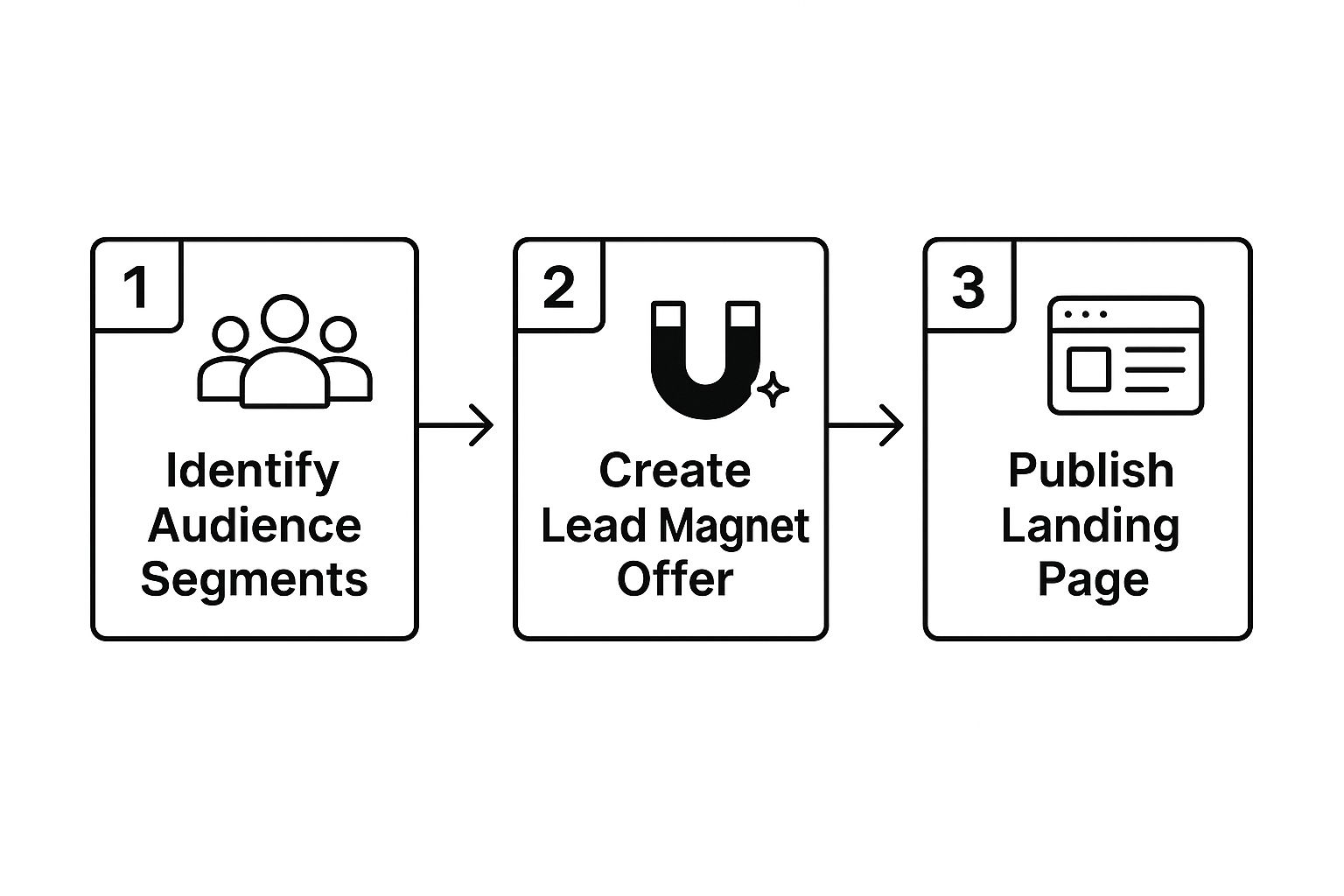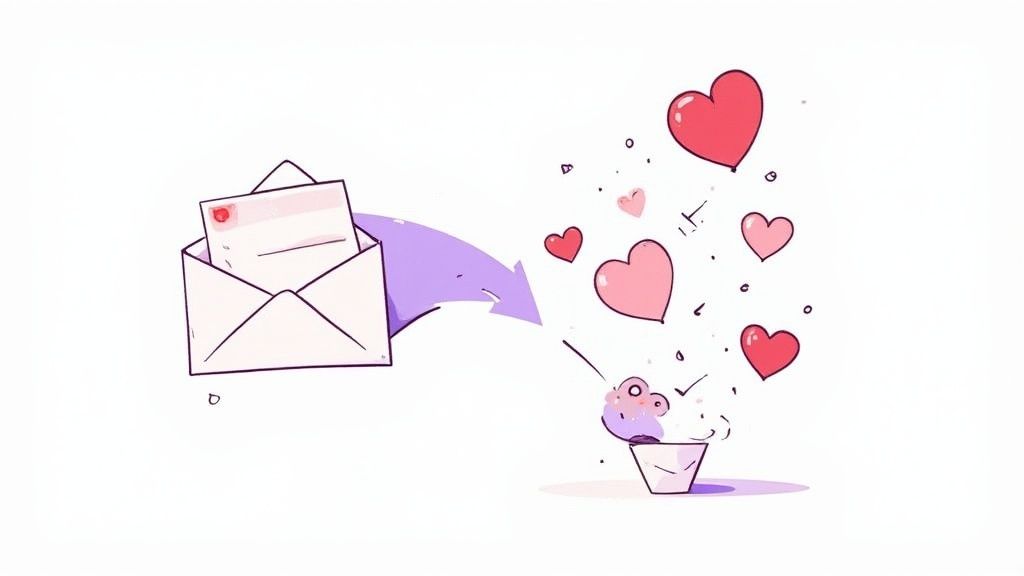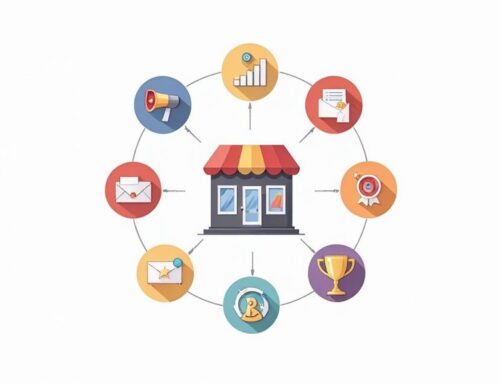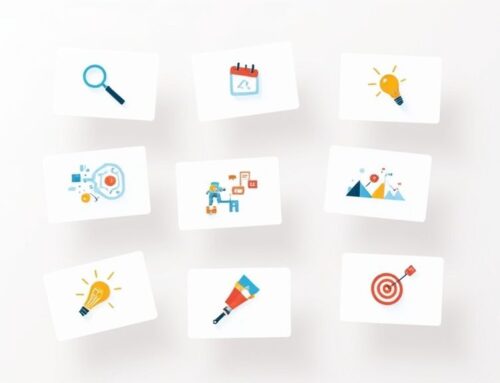Let’s be real for a moment. Nobody likes being sold to, but everyone loves to buy. That simple truth is the heart of inbound marketing lead generation. Instead of shouting at potential customers with ads and cold calls, you draw them in naturally by being genuinely helpful.
It’s a different way of thinking. You become the go-to resource, the trusted advisor who solves their problems with great content and valuable experiences. This approach builds a deep sense of trust from the very first interaction, creating a steady stream of leads who are actually happy to hear from you.
Why Inbound Beats Outbound for Sustainable Growth
We’ve all been on the receiving end of traditional outbound marketing. It’s the unsolicited email cluttering your inbox, the pop-up ad that hijacks your screen, or the cold call that interrupts your dinner. Outbound marketing pushes a message on people, whether they asked for it or not. In today’s world, where buyers are incredibly skilled at tuning out noise, that interruption-based model is simply losing its punch.
Inbound marketing completely flips that script. Rather than chasing down customers, you create a magnetic presence that pulls them toward you. The entire strategy is built on a foundation of trust and a fair exchange of value. You offer up helpful content—think detailed blog posts, comprehensive guides, or insightful videos—that directly addresses the pain points and questions your ideal customers are searching for online.
This shift from interruption to attraction is why inbound marketing isn’t just a “nice to have” anymore. It’s a fundamental part of building a business that can stand the test of time. It’s how you build a reliable system that consistently brings the right people to your digital front door.
The Power of Pull vs. Push
At its core, inbound operates on the “Attract, Engage, Delight” flywheel. First, you attract strangers with content that solves a problem. Then, you engage them with personalized conversations and solutions. Finally, you delight them with such a great experience that they become advocates for your brand. Each stage is an opportunity to provide real value, which translates directly into a predictable pipeline of qualified leads.
This isn’t just a feel-good theory; the numbers tell a compelling story. Inbound tactics have been proven to generate 54% more leads than traditional outbound methods. And it’s not just about volume—it’s about efficiency. The cost per lead with inbound is almost always significantly lower. If you’re curious, you can dig into more of these powerful inbound marketing stats to see just how effective it can be.
The real magic of inbound is that it perfectly aligns with how people make decisions today. We all do our own research online before making a purchase. By being the most helpful and authoritative resource during that research phase, you make your brand the obvious choice when it’s time to buy.
Before we go deeper, let’s quickly break down the fundamental differences between these two approaches.
Inbound vs. Outbound Lead Generation At a Glance
The table below offers a straightforward comparison, highlighting the key distinctions in approach, cost, and the quality of leads each method typically produces.
| Attribute | Inbound Marketing | Outbound Marketing |
|---|---|---|
| Approach | Attracts customers with helpful content (Pull) | Pushes messages onto a broad audience (Push) |
| Communication | Two-way, permission-based conversations | One-way, often unsolicited interruption |
| Lead Quality | Higher quality, self-qualified leads | Lower quality, broad, and often unqualified |
| Cost-Effectiveness | Lower cost-per-lead, builds long-term assets | Higher cost-per-lead, relies on continuous ad spend |
| Customer Trust | Builds trust and authority over time | Can erode trust if perceived as spammy or intrusive |
| ROI | Compounding returns as content assets grow | Diminishing returns; stops when you stop paying |
As you can see, the contrast is stark. One method builds a relationship, while the other simply broadcasts a message.
Building an Asset, Not Just Running a Campaign
Think of outbound marketing like renting an audience. The moment you stop paying for ads or making calls, the lead flow dries up. It’s a constant expense with no lasting value.
Inbound marketing is completely different—it’s about building a valuable asset for your business. Every blog post you publish, every video you upload, and every guide you offer becomes a digital resource that can work for you 24/7, generating leads for months or even years to come.
This creates a powerful compounding effect. Your efforts stack on top of each other, strengthening your online authority and search rankings over time. This is how you build true brand loyalty and generate a return on investment that short-term “push” advertising could never match. You’re not just running a campaign; you’re building a sustainable engine for growth.
Building Your Foundation with Deep Audience Insights

Before you write a single blog post or design a landing page, you have to answer the most important question in all of marketing: who are we actually talking to?
Seriously. Everything hinges on this. Without a crystal-clear picture of your audience, you’re just making noise. True inbound marketing lead generation begins with getting inside your ideal customer’s head.
We’re not just talking about basic demographics like age, location, or job title. That’s surface-level stuff. To really connect, you need to understand their world. What problems keep them staring at the ceiling at 2 AM? What are their biggest career goals? What little daily frustrations could your product or service completely erase? This is how you go from a generic profile to a powerful buyer persona.
Think of a buyer persona as a semi-fictional character you build from real-world data. It might feel a bit like an exercise, but it’s a strategic game-changer. When you can say, “Okay, this ebook is for ‘Marketing Mary’,” every decision—from the headline to the call-to-action—suddenly becomes sharper and more relevant.
Digging for Data (Not Guesswork)
Great personas aren’t just invented in a conference room. They’re built on a solid foundation of real data, both qualitative and quantitative. You need to put on your detective hat and start gathering clues. Your mission is to find hard evidence of your customer’s challenges, what drives them, and how they like to communicate.
Here are a few of the most effective ways I’ve seen teams gather this intel:
- Talk to Your Customers: This is non-negotiable. Pick up the phone and interview your best customers. Ask them what problem they had before they found you and what the tipping point was. These conversations are absolute gold.
- Listen to Your Sales Team: Your sales reps are on the front lines every single day. They hear every objection, every question, every hesitation. A quick 30-minute sync with them can give you more content ideas than a week of brainstorming.
- Use Quick Surveys: You can use simple tools like SurveyMonkey or even a Google Form to poll your email list or website visitors. Ask one simple question: “What’s the #1 challenge you’re facing right now with [your topic]?”
- Be a Fly on the Wall: Lurk in the LinkedIn groups, subreddits, or industry forums where your audience hangs out. What questions do they ask over and over again? Pay attention to the exact words they use.
The most powerful insights are often buried in the specific language your customers use. When you hear them describe their problems, write down their exact phrasing. Mirroring that language in your marketing makes them feel instantly understood.
Once you have this raw data, you can start building your persona. Give them a name, a job, and a backstory. Humanize the data. This makes it infinitely easier for your whole team to create content that speaks to a real person, not just a faceless market segment.
Charting the Buyer’s Journey
Knowing who you’re talking to is step one. Step two is knowing where they are in their decision-making process. This is what we call the buyer’s journey—the active research path someone takes from realizing they have a problem to finally choosing a solution.
This journey is typically broken down into three main stages:
- Awareness Stage: The person is just realizing they have a problem or a goal, but they haven’t put a name to it yet. They’re looking for answers, resources, and education. For example, they might be searching, “Why is my website traffic going down?”
- Consideration Stage: Now, they’ve clearly defined their problem and are actively researching all the possible solutions. They’re comparing different approaches and methods. A search might look like, “How to improve SEO vs. running paid ads.”
- Decision Stage: The prospect has zeroed in on the type of solution they want and is now comparing specific products or companies. They’re looking for proof. Think searches like, “ReachLabs.ai vs. competitor reviews” or “Acme Corp case studies.”
When you map your persona’s key questions to each of these stages, you essentially create the blueprint for your entire content strategy. It ensures every piece of content has a job to do in your inbound marketing lead generation funnel, smoothly guiding people from one stage to the next. This foundational work isn’t just important; it’s what separates the campaigns that succeed from the ones that flop.
Creating High-Value Content That Attracts and Converts

Alright, you’ve done the foundational work—you know your audience inside and out. Now it’s time to build the engine of your inbound marketing lead generation machine: the content itself. This isn’t about just hitting a publishing quota. Every single piece you create needs a job to do, whether that’s attracting the right kind of attention or gently nudging someone toward the next step.
The mindset shift here is crucial. Stop thinking like a marketer and start acting like a publisher. Your aim is to create content so genuinely useful that people would’ve gladly paid for it. That’s the secret sauce—offering real value upfront builds the trust you need to earn their contact information later.
Matching Content to the Buyer’s Journey
Those buyer personas and journey maps you built? They’re not just fancy documents; they are your content creation blueprints. They tell you exactly what your audience needs to hear and when they need to hear it.
Let’s make this real. Imagine your ideal customer is “Startup Steve,” a founder laser-focused on scaling his new SaaS company.
- Awareness Stage: Steve is just starting to feel the growing pains. He isn’t looking for your solution yet; he’s Googling his problems. Your content here needs to be educational and problem-focused. Think blog posts like “10 Growth Hurdles Every SaaS Startup Hits” or a simple, helpful checklist like “Is Your Startup Really Ready to Scale?”
- Consideration Stage: Okay, Steve has a name for his problem: he needs a better lead generation system. Now he’s actively researching solutions. This is where you can go deeper. A webinar on “How to Build a Scalable Lead Gen Engine” would be perfect, or a comprehensive guide comparing inbound marketing vs. paid ads for SaaS companies.
- Decision Stage: Steve is close to making a call. He’s narrowed down his options and needs to feel confident that you’re the right choice. Your content must seal the deal. This means powerful case studies, no-brainer free trial offers, and transparent pricing pages that answer his final questions.
When you align your content this way, you create a natural, seamless path that guides people from being a curious stranger to a confident customer. This strategic alignment is a cornerstone of effective B2B lead generation. We go even deeper into this in our guide to building a robust B2B lead generation strategy.
Building Authority with Pillar Pages and Topic Clusters
If you want to truly own a topic in the eyes of Google and your audience, you have to move beyond just publishing one-off blog posts. The most powerful strategy I’ve seen in recent years is the pillar page and topic cluster model. It’s a game-changer for organizing your content and signaling expertise.
A pillar page is your cornerstone piece—a massive, in-depth guide covering a broad topic from top to bottom. Think “The Ultimate Guide to Inbound Marketing for SaaS.”
Topic clusters are the supporting cast. They are smaller, more focused blog posts that dive into specific subtopics mentioned on the pillar page, and they all link back to it.
Think of it like a book. The pillar page is the book itself, giving a broad overview of the subject. The topic clusters are the individual chapters, each diving deep into a specific aspect of that subject. This structure signals to Google that you have deep expertise on the topic.
This creates a powerful, interconnected web of content. It’s incredibly helpful for users who want to learn, and it makes it crystal clear to search engines what you’re an authority on. The payoff? Higher rankings for the keywords that matter most to your business.
Fueling Your Funnel with the Right Content Mix
The data doesn’t lie: content is a powerhouse for lead generation. We’re talking about a strategy that’s three times more efficient than traditional outbound marketing. In fact, 72% of companies see a direct increase in leads thanks to their content efforts.
And blogging is a beast of its own. Businesses that get serious and publish at least 16 blog posts a month can generate 4.5 times more leads than those posting just a few times. The evidence is overwhelming.
To make it work, you need a diverse mix of content that speaks to people at every stage of their journey.
Top-of-Funnel (ToFu) Content for Awareness:
- Blog Posts: The workhorse. Answer questions, solve small problems, and pull in organic traffic.
- Infographics: Break down complex ideas into shareable, easy-to-digest visuals.
- Social Media: Engage your community and drive traffic with short, punchy updates.
Middle-of-Funnel (MoFu) Content for Consideration:
- Ebooks & Guides: Your primary lead magnets. Offer a deep dive in exchange for an email.
- Webinars: Go in-depth, answer live questions, and build a direct connection.
- Case Studies: Show, don’t just tell. Prove your value with real-world success stories.
Bottom-of-Funnel (BoFu) Content for Decision:
- Free Trials or Demos: Let them kick the tires and see the value for themselves.
- Consultations: Offer personalized, expert advice to help them make the final call.
- Pricing & Comparison Pages: Be transparent and make it easy for them to justify the purchase.
By thoughtfully building out this library of assets, you create a resilient content machine that works for you 24/7, consistently feeding your inbound marketing funnel with qualified leads.
Optimizing Your Channels for Maximum Lead Capture
Creating fantastic content is the first major battle, but it’s a wasted effort if no one ever sees it. Now we pivot from creation to amplification and conversion. This is where we make sure the right people find your valuable resources and, more importantly, take that crucial step to become a lead. A successful inbound marketing lead generation strategy really boils down to how well you turn your traffic into tangible contacts.
This whole process is a powerful partnership between search engine optimization (SEO) and conversion rate optimization (CRO). Think of it this way: SEO brings qualified visitors to your digital doorstep, while CRO convinces them to come inside. You need both. Without them, you either have a beautiful, empty storefront or a crowd of window shoppers who never buy a thing.
Mastering SEO for Lead Generation
Let’s face it, your audience is on Google, actively searching for answers. Your job is to show up right when they need you. This isn’t about trying to game the system; it’s about making it incredibly easy for search engines to understand what your content is about and recognize its value.
It all starts with making sure every piece of content is built around a primary keyword your ideal customer would actually type into the search bar. For instance, a marketing manager in the early “awareness” stage is probably searching for “how to increase website traffic,” not a generic term like “traffic.” Tools like Ahrefs or Semrush are indispensable for uncovering these high-intent phrases that signal someone is looking for help.
From there, nail these on-page SEO fundamentals:
- Title Tag: Get your main keyword in the page title, and try to place it near the beginning. It’s one of the strongest signals you can send.
- Meta Description: While not a direct ranking factor, a great meta description is your ad on the search results page. It needs to be compelling enough to entice someone to click your link over a competitor’s.
- Readable URL: A clean URL like
yourwebsite.com/blog/inbound-marketing-guideis far better for both users and search engines than a jumbled mess likeyourwebsite.com/p?id=123. - Internal Linking: Don’t forget to link your relevant blog posts together. This keeps users on your site longer and helps Google understand how your content is related, which is key for building topical authority.
A huge piece of the SEO puzzle that people often forget is the actual user experience. Google’s main goal is to send its users to pages they’ll love. That means your site absolutely must load quickly, be mobile-friendly, and be a breeze to navigate. A slow or clunky website will sabotage your rankings and your conversion rates.
Designing Landing Pages That Actually Convert
Once a visitor lands on your site from a search or social media post, the mission shifts entirely to conversion. This is where your landing pages, calls-to-action (CTAs), and forms have to do the heavy lifting. A poorly designed landing page can completely neutralize your amazing content.
A high-impact landing page is ruthlessly focused on a single goal: getting the visitor to take one specific action. That means stripping away all distractions. Get rid of the main navigation menu, the sidebar, anything that could pull their attention away from the offer.
Every element on the page needs to work in harmony:
- A Clear, Benefit-Driven Headline: Don’t just state what the offer is; explain what the user will get. Instead of “Download Our Ebook,” try something like, “Get Your Free Guide to Doubling Your Leads in 90 Days.” See the difference?
- Scannable Bullet Points: Most people scan before they read. Use bullet points to break down the key takeaways and benefits of your offer, making the value proposition dead simple to grasp in seconds.
- Compelling Visuals: Include an image of the ebook cover or even a short video. This makes the offer feel more tangible and valuable, increasing the perceived worth.
The Art of the Call-to-Action and Form
Your call-to-action (CTA) is the button that kicks off the conversion. It needs to be visually prominent and use action-oriented language. Words like “Get,” “Download,” or “Access” are far more powerful than a passive “Submit.”
Finally, take a hard look at your form. The more information you ask for, the lower your conversion rate will be—that’s a guarantee. Start by asking for only what is absolutely necessary, which is usually just a name and an email address. You can always gather more intel later on as you nurture them. For a top-of-funnel ebook, asking for their phone number and company size is probably too much, too soon. Making this one simple adjustment can dramatically improve your inbound marketing lead generation results.
Nurturing Leads with Smart Automation
Getting a new lead is a great first step, but it’s just that—a first step. A massive mistake I see companies make all the time is tossing every new contact straight to the sales team. The hard truth is most people who download your content aren’t anywhere near ready for a sales pitch. This is where smart automation becomes your secret weapon for inbound marketing lead generation.
By setting up an automated nurturing system, you can guide people along their own buying journey, building trust and delivering value without lifting a finger for each interaction. This system works 24/7, making sure no lead gets forgotten and, just as importantly, that your sales team only talks to people who are actually ready to buy.
This isn’t just about efficiency; it’s about protecting your investment. Businesses generate an average of 1,877 leads a month, and that comes at a steep price—the average cost per lead is a whopping $198.44. When you realize that 44% of sales reps admit they’re too swamped to follow up with every lead, it becomes crystal clear why a solid system is non-negotiable.
Building Your Automated Nurture Sequences
At the heart of lead nurturing is the automated email sequence. No, this isn’t an excuse to spam your contacts. It’s a carefully planned series of emails meant to educate, solve problems, and gently move prospects closer to making a decision. You want them to feel like you understand their challenges and are there to help.
It helps to map this out visually. Before you write a single email, you have to know who you’re talking to and what you can offer them that’s genuinely valuable.

This kind of flow chart really drives home the point: your nurture sequence is only as good as your audience research and the quality of your content.
A practical way to approach this is to create unique workflows for each of your lead magnets. For instance, if someone downloads an ebook about “SaaS Growth Hurdles,” the follow-up emails should stick to that theme.
To give you a better idea, here’s a simple workflow you could build out in a tool like HubSpot or ActiveCampaign.
Sample Lead Nurturing Workflow
This table shows a basic 3-step sequence for a new lead who downloaded a top-of-funnel ebook.
| Step | Trigger | Action | Goal |
|---|---|---|---|
| Email 1 | Immediate | Send a welcome email that delivers the ebook. | Provide instant value and confirm the download. No sales pitch. |
| Email 2 | Wait 2 days | Send an email with a link to a related blog post or a quick video tip. | Offer additional value and build credibility on the topic. |
| Email 3 | Wait 4 days | Invite them to a webinar or share a relevant case study. | Move them toward a middle-of-funnel offer and show social proof. |
This gradual process keeps your brand top-of-mind without being pushy. If you want to dive deeper into setting these systems up, check out this guide on creating a powerful marketing automation strategy.
Using Lead Scoring to Spot Sales-Ready Leads
So, how do you know when a lead is finally warm enough to pass to sales? That’s where lead scoring comes in. It’s a system where you assign points to contacts based on who they are (demographics) and what they do (their behavior).
You can set up rules in your automation platform to add or subtract points automatically. This gives you a dynamic score that shows you exactly how engaged someone is.
- Positive Signals (Add Points):
- Job Title is Director or VP (+15 points)
- Company Size fits your ideal customer profile (+10 points)
- Visited the pricing page (+20 points)
- Downloaded a bottom-of-funnel case study (+10 points)
- Opened a recent email (+1 point)
- Negative Signals (Subtract Points):
- Unsubscribed from your email list (-50 points)
- Has a personal email address (e.g., Gmail, Yahoo) (-5 points)
Pro-Tip: Set a score threshold—let’s say 100 points—that automatically triggers a notification to your sales team. This simple handoff ensures they spend their valuable time on prospects who are actively showing buying intent, which can dramatically improve their close rates.
Measuring Your Success and Refining Your Strategy

Here’s the hard truth: an inbound strategy without measurement is just expensive guesswork. To get real results from inbound marketing lead generation, you have to treat it like a science. You’re constantly observing data, forming a hypothesis, and then tweaking your approach based on what you learn.
Without that feedback loop, you’re flying blind, likely wasting time and money on tactics that feel productive but don’t actually move the needle.
The whole point isn’t to create flashy reports packed with vanity metrics like page views. It’s about drawing a straight line from your marketing activities to real business outcomes. You need to know which blog post delivered the most qualified leads or which landing page converts visitors into contacts most effectively. This data tells you a story about what your audience truly wants.
Identifying Your Core KPIs
To avoid getting lost in a sea of data, you need to zero in on a handful of Key Performance Indicators (KPIs) that truly reflect the health of your funnel. These are the metrics that show you what’s working and, more importantly, where you’re losing people.
I’d recommend starting with these essentials:
- Visitor-to-Lead Conversion Rate: This is the heartbeat of your lead generation. It’s simply the percentage of website visitors who take the next step and fill out a form. A low rate here could point to a weak call-to-action, a confusing landing page, or a mismatch between your ad and your offer.
- Cost Per Lead (CPL): This one is crucial for your budget. You calculate it by dividing your total marketing spend by the number of new leads you generated in that same period. It gives you a clear picture of how efficient your inbound machine is from a financial standpoint.
- Marketing Qualified Leads (MQLs): Using the lead scoring you set up earlier, track how many leads meet the criteria to be considered “marketing qualified.” This number shows you the volume of prospects who are genuinely engaged and ready for your sales team to nurture.
Of course, knowing the numbers is just the first step; the real magic is in the interpretation. For a deeper dive, our guide on how to measure marketing campaign success can help you build reports that actually lead to action.
My advice: Don’t fall into the trap of “analysis paralysis.” Pick 3-5 core KPIs and check them weekly. This focus makes it so much easier to spot trends and make quick, informed decisions instead of drowning in spreadsheets.
Using Data to Refine and Iterate
Once your KPIs are established, you can start making smarter, data-backed decisions.
Let’s say you notice one of your blog posts has a surprisingly high visitor-to-lead conversion rate. That’s not just a lucky break; it’s a powerful signal from your audience. It’s telling you that the topic, the angle, and the lead magnet you offered hit the bullseye.
So, what’s your next move? You double down. You could create a webinar on that exact topic, produce a more comprehensive downloadable guide, or spin it off into a series of short, impactful social media videos. This is how you shift from simply creating content to strategically building a resource engine that works for you 24/7.
This cycle—measure, learn, refine—is what drives sustainable growth. It’s the engine of any successful inbound program.
Common Questions About Inbound Marketing
Diving into inbound marketing for the first time? It’s natural to have questions. Over the years, I’ve heard just about all of them, but a few pop up constantly. Here are my straight-to-the-point answers based on real-world experience.
How Long Does It Really Take to Get Leads?
Let’s get one thing straight: inbound marketing is not a quick fix. It’s a long-term investment, more like planting an orchard than flipping a switch. You’re building a sustainable asset for your business.
While some lucky early results can trickle in within the first few months, you should plan for a solid 6-12 months of consistent work before you see a predictable, steady stream of quality leads. This is the time it takes to build up real authority with search engines and earn the trust of your audience.
Of course, this timeline isn’t set in stone. It can speed up or slow down depending on:
- How crowded your industry is.
- How aggressively you’re creating and promoting great content.
- Your starting line—do you already have some website authority, or are you starting from scratch?
Is This Just for B2B, or Does It Work for B2C Too?
Absolutely, it works for both. The fundamental idea of pulling customers in with valuable content applies universally. The difference isn’t if it works, but how you apply it.
For my B2B clients, the focus is often on navigating a longer, more complex sales cycle. We build trust and prove expertise with things like in-depth whitepapers, detailed case studies, or technical webinars. It’s all about guiding a buying committee through a high-stakes decision.
With B2C, the game is often faster and more emotional. Success might come from building a vibrant community on social media, partnering with influencers your audience loves, or creating fun, shareable blog posts. The key is always to tailor your approach to how your specific audience thinks and shops.
If you force me to pick the single most critical piece of the puzzle, it’s this: a deep, almost obsessive understanding of your audience, documented in your buyer personas. If you don’t know their real problems, what gets them excited, and the questions they’re secretly asking Google, your content will never connect. Your whole strategy will be a shot in the dark.
Ready to build a powerful inbound engine that delivers predictable growth? The team of specialists at ReachLabs.ai can help. We combine data-driven strategy with world-class creative to build marketing campaigns that attract, engage, and convert your ideal customers. Learn more about our approach at https://www.reachlabs.ai.





